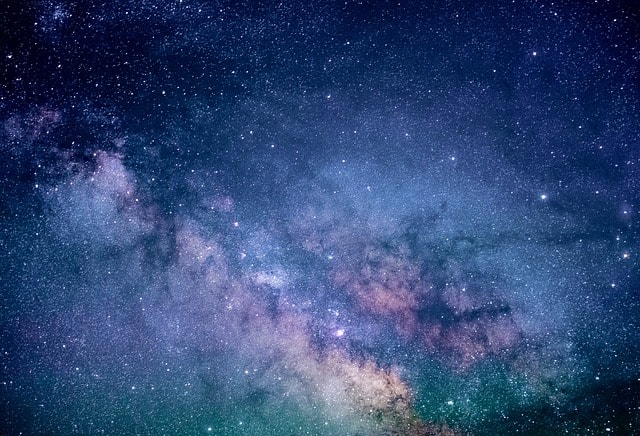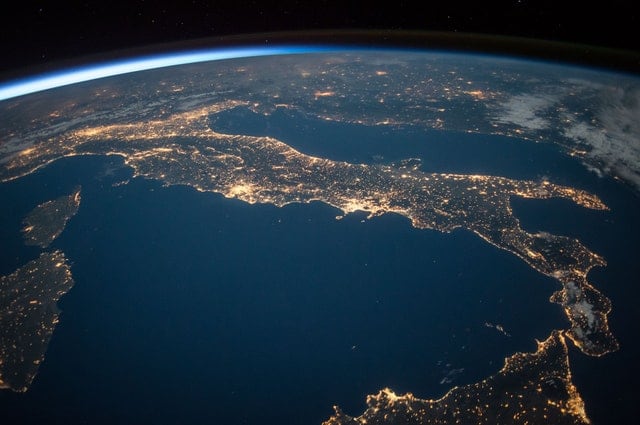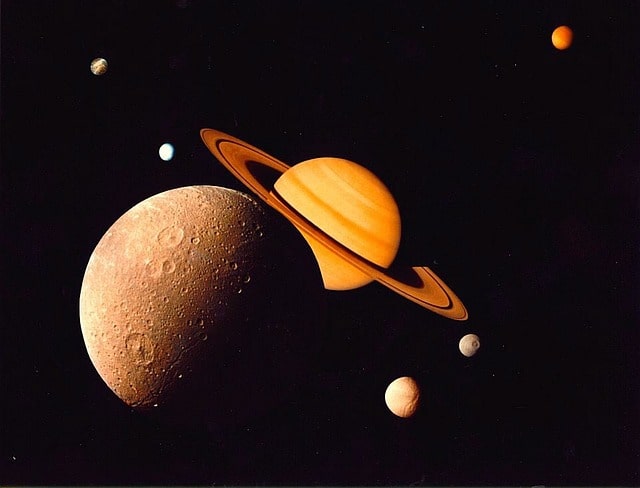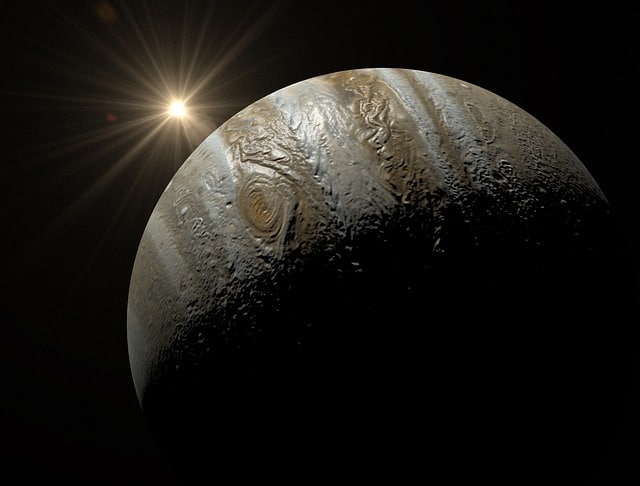What are Different Types of Stars and What They Mean

Our sun is a star. It’s bright because we’re close to it. If we could swap out our sun with another star, the dimmest would appear as a tiny dot not even as bright as our full Moon. If we replaced it with Rigel the bright star at the foot of Orion, it would cover a large portion of the sky, burning up the Earth in a few seconds, at 57,000 times the brightness of our own sun.
Most, and perhaps all, of the stars in our night sky have planets like those in our own solar system. In fact, many of the stars closest to Earth have planets.
Stars are like the fireplace we huddle around to stay warm in the cold darkness of night. Stars give off their own light and heat.
Planets merely reflect the light given off by their suns. So, what kinds of stars are there? Let’s start with our own sun for comparison.
Our Own Sun
Our own sun is a bright yellow, main sequence star, about 4.5 billion years old, with a moderate amount of heavier elements like iron, oxygen, and silicon. The name of our sun is Sol.
- Spectral Type: G2V
- Mass: 1 Sol (333,000 Earths).
- Metallicity: 0
- Age: 4.5 billion years. (We have another 5.5 billion years before our sun becomes a sub-giant).
- Distance: 0 light years (93 million miles from Earth).
The Life of a Star
Stars begin as protostars, then enter the main sequence, become sub-giants and then giants. The most massive even become super-giant stars. After that, stars become either white dwarfs, neutron stars or black holes.
Proto-Stars
Proto-stars are very young stars that are considered pre-main sequence. Their ages range from zero to 100 million years. This is the period when a star is born from dust and gas in interstellar space. This is the period before a star ignites the hydrogen at its core.
Example: T Tauri
- Spectral Type: G5V:e.
- Mass: 0.53
- Radius: ?
- Age: 0.4 million years
- Distance: 471 light years
Main Sequence Stars
These are stars that are considered mature. They are burning hydrogen at their core. Main sequence stars are fairly common. This group includes:
- Red dwarfs—the least massive main sequence stars
- Orange dwarfs—slightly more massive
- Yellow dwarfs—mid-range mass
- Blue dwarfs—more massive
- Ultraviolet dwarfs—most massive main sequence stars
Red Dwarfs
Low mass stars that give off far less light than our own sun, mainly toward the red end of the spectrum.
- Spectral Types: M9V–M0V
- Mass Range: 0.075–0.45 Sols
- Maximum Age: Trillions of years (older than the current universe).
- How Common: 76.45% of all main sequence stars
Example: Alpha Centauri C (Proxima Centauri)
- Spectral Type: M5.5e.
- Mass: 0.122 Sols
- Radius: 0.1542 Sols
- Metallicity: 21.
- Age: 5.3 billion years
- Distance: 4.244 light years
Orange Dwarfs
Stars less massive than our own sun that shine mainly in the orange range of the spectrum.
- Spectral Types: K9V–K0V.
- Mass Range: 0.45–0.8 Sols
- Maximum Age: 73 billion years (K9V)
- How Common: 12.1% of all main sequence stars
Example: Alpha Centauri B
- Spectral Type: K1V
- Mass: 0.907 Sols
- Radius: 0.8632 Sols
- Metallicity: 23
- Age: 5.3 billion years
- Distance: 4.37 light years
Yellow Dwarfs
Stars similar to our own sun that range from deep yellow to hot, yellow-white.
- Spectral Types: G9V–G0V, F9V–F0V
- Mass Range: 0.8–1.4 Sols
- Maximum Age: 17.5 billion years (G9V); 9.1 billion years (F9V).
- How Common: 10.6% of all main sequence stars
Example: Alpha Centauri A
- Spectral Type: G2V
- Mass: 1.1 Sols
- Radius: 1.2234 Sols
- Metallicity: 2
- Age: 5.3 billion years
- Distance: 4.37 light years
Example: Tau Ceti
- Spectral Type: G8V
- Mass: 0.783 Sols
- Radius: 0.793 Sols
- Metallicity: –0.55. (Fairly metal poor for a main sequence dwarf)
- Age: 5.8 billion years
- Distance: 11.905 light years
Blue Dwarfs
Stars more massive than our sun that emit light more toward the blue end of the spectrum.
- Spectral Types: A9V–A0V, B9V–B0V.
- Mass Range: 1.4–16 Sols
- Maximum Age: 4.3 billion years (A9V); 1.56 billion years (B9V)
- How Common: 0.73% of all main sequence stars
Example: Sirius (Alpha Canis Majoris)
- Spectral Type: A1V
- Mass: 2.063 Sols
- Radius: 1.711 Sols
- Metallicity: 0.50
- Age: 242 million years
- Distance: 8.6 light years
Example: Alkaid (Eta Ursae Majoris)
- Spectral Type: B3V
- Mass: 6.1 Sols
- Radius: 3.4 Sols
- Age: 10 million years
- Distance: 103.9 light years
Ultraviolet Dwarfs
Very massive main sequence stars that emit light largely in the blue and ultraviolet range.
- Spectral Types: O9V–O5V.
- Mass Range: ≥ 16
- Maximum Age: 9.77 million years (O9V).
- How Common: 0.13% of all main sequence
Example: HD 93129 B
- Spectral Type: O3.5V(f)z.
- Mass: 52 Sols
- Radius: 13 Sols
- Age: 0.9 million years
- Distance: 7,500 light years
Subdwarfs
Below the main sequence are a class of stars that are less luminous than main sequence stars. This is because they don’t have as much of the extra elements found in stars like our sun. They have almost no oxygen, iron, carbon, lithium and other elements that make our own sun burn brighter.
Their luminosity class is “VI.” So, a sub-dwarf star of the same temperature as our sun would have a spectral type of G2VI. Out of roughly 200 billion stars in our Milky Way galaxy, roughly half of them are subdwarfs, making them the most numerous type known.
Example: Groombridge 1830
- Spectral Type: G5VIp
- Mass: 0.661 Sols
- Radius: 0.681 Sols
- Age: 5.0 billion years
- Distance: 29.7 light years
Example: Mu Cassiopeiae
- Spectral Type: G5VIb
- Mass: 0.74 Sols
- Radius: 0.791 Sols
- Age: 4.5 billion years
- Distance: 24.6 light years
Brown Dwarfs
These are failed stars that have insufficient mass to ignite their nuclear cores.
They glow only from the heat of compression. Some of them glow in the visible range, but most of their light is in the infrared range (beyond red). Because they are so dim, they are difficult to detect. They may be far more common than red dwarfs, but we’re still learning about them.
Example: Luhman 16A
- Spectral Type: L8
- Mass: 0.032 Sols
- Radius: ?
- Age: ?
- Distance: 6.516 light years
Example: Epsilon Indi Ba
- Spectral Type: 0V
- Mass: 0.066 Sols
- Radius: 0.08 Sols
- Age: 1.3 billion years
- Distance: 11.81 light years
Sub-Giants
These are stars that have evolved away from the main sequence on their way to becoming red giants—mainly K, G, and F types.
- Spectral Types: M9IV–O7IV.
- How Common: Moderately rare
Example: Gamma Cephei
- Spectral Type: K1IV CN1
- Mass: 1.41 Sols
- Radius: 4.93 Sols
- Age: 3.25 billion years
- Distance: 44.9 light yeats
Example: Beta Scorpii Aa
- Spectral Type: 5IV (one star in a six-sun system).
- Mass: 15.0
- Radius: 6.3
- Age: 6.3 million
- Distance: ~400 light
Giants
These are stars that have stopped burning hydrogen as their main fuel and are now using helium to create their energy.
- Spectral Types: M9III–O9III.
- How Common: Very rare
Example: Aldeberan (Alpha Tauri)
- Spectral Type: K5III
- Mass: 1.16 Sols
- Radius: 44.13 Sols
- Age: 6.4 billion years
- Distance: 65.3 light years
Example: Thuban A (Alpha Draconis A)
- Spectral Type: K5III
- Mass: 2.8 Sols
- Radius: 3.4 Sols
- Distance: 303 light years
Super-Giants
These are very massive stars that are burning helium or carbon in their cores. If the star is massive enough to form an iron core, it will likely end its life as a supernova.
- Spectral Types: M9I–O9I.
- How Common: Extremely rare
Example: Rigel A (Beta Orionis A)
- Spectral Type: B8Ia
- Mass: 21 Sols
- Radius: 78.9 Sols
- Age: 8 million years
- Distance: 860 light years
Example: Betelgeuse (Alpha Orionis)
- Spectral Type: M1Ia
- Mass: 6 Sols
- Radius: 955 Sols
- Age: 8.3 million years
- Distance: 725 light years
White Dwarfs
White dwarfs are the end result of very old stars that has gone past their red giant phase and shrugged off their outer layers, leaving only the collapsed core which is typically about the size of our planet Earth, but dense enough for a tablespoon of its mass to weigh several tons.
- Spectral Types: Commonly start with letter “D” for degenerate star
- Duration: Trillions of years
- How Common: ~5% of the count of the main sequence stars
Example: Sirius B
- Spectral Type: DA2
- Mass: 1.018 Sols
- Radius: 0.0084 Sols
- Age: 228 million years
- Distance: 8.6 light years
Example: Procyon B
- Spectral Type: DQZ
- Mass: 0.602 Sols
- Radius: 0.012 Sols
- Age: 1.37 billion years
- Distance: 11.46 light years
Black Dwarfs
A black dwarf is the end result of a white dwarf that has cooled down so that it no longer emits any visible light. So far, the universe is not old enough for any white dwarfs to have cooled to this extent.
- Spectral Types: None (no light emitted).
- Duration: Unknown. Probably as long as the universe
- How Common: 0% of all stars. The universe isn’t old enough,
Neutron Stars
These are stars that have a mass between 10–29 solar masses (Sols) before they explode as a supernova. The shock of the explosion compresses the core to become more dense than a white dwarf. Some neutron stars give off pulses of energy; these are called pulsars.
- How Common: Only about 2,000 are known in the Milky Way and Magellanic
Clouds. This amounts to ~0.000001% of the stars.
Example: PSR J0108−1431
- Spectral Type: Pulsar
- Mass: ?
- Radius: ?
- Age: 166 million
- Distance: 424 light
Example: PSR B1257+12
- Spectral Type: Pulsar
- Mass: 1.4 Sols
- Radius: 10 kilometers (~0.000015 Sols).
- Age: ~2 billion
- Distance: 2,300 light years
Black Holes
A black hole is the super-massive end result of a collapsed star after a supernova explosion.
- Spectral Types: None (no light directly emitted).
- Duration: Unknown. May last as long as the universe
- How Common: Unknown because they don’t emit any light. We only know of some black holes because of their influence on other, nearby objects, or from the material falling into them from nearby
Example: Cygnus X-1
- Spectral Type: None
- Mass: 14.8
- Radius of Event Horizon: ~300
- Age: 5 million
- Distance: ~6,500 light
Other Types
There are numerous other types of stars, including novae, recurrent novae, and supernovae. Within some of the categories, above, there are also some stars that vary in brightness on a fairly regular basis. Delta Scuti variables, for instance, vary with such precision, that they are used as a crude measuring stick to nearby galaxies.
Sources:
Astronomy for Beginners. (ND). “10 closest stars to earth known to have planets.” Retrieved on May 1, 2019 from https://astronomyforbeginners.com/astronomy/ closest-stars-to-earth/
Garrison, R.F. (1994). “A Hierarchy of Standards for the MK Process.” Retrieved on May 1, 2019 from https://ui.adsabs.harvard.edu/abs/1994ASPC…60….3G/abstract
Johnson, H.L., and Morgan, W.W. (1953). “Fundamental stellar photometry for standards of spectral type on the Revised System of the Yerkes Spectral Atlas.” Retrieved on May 1, 2019 from https://ui.adsabs.harvard.edu/abs/1953ApJ…117..313J/abstract
SpaceSoftware. (ND). Stars in the NeighborHood software. Retrieved on May 1, 2019 from https://spacesoftware.wordpress.com/





